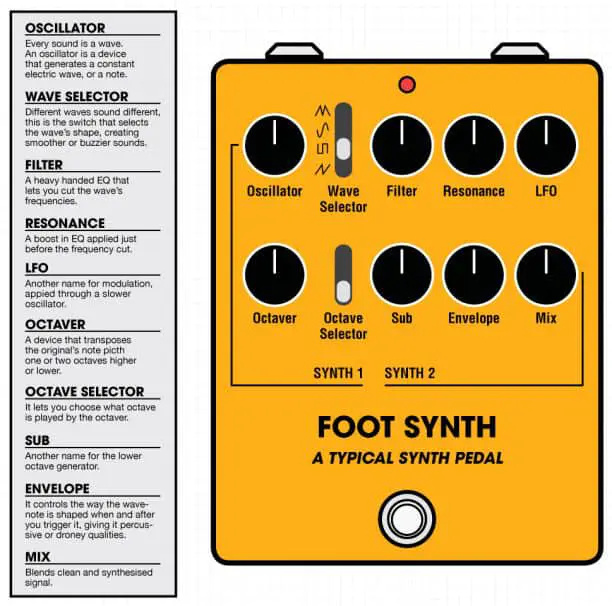Written by Christopher Scapelliti, Nicholas Kula and Paolo De Gregorio, this article appeared in print in the 2nd issue of the Delicious Audio magazine and can be read with enhanced streaming digital content here.
—
In September 1963, as the Beatles convened in Abbey Road Studios to record “Don’t Bother Me” for their second album, With the Beatles, George Harrison was curious to know if it was possible to make his guitar sound like another instrument. “Can we have a compressor on this guitar?” he asked audio engineer Norman Smith. “We might try to get a sort of organ sound.”
Poor George was born a few decades too early. Had he made such a request today, he’d have a wealth of effect pedals from which to choose, several of which are designed explicitly to make a guitar sound like an organ. Advances in digital signal processing have made it possible for effect makers to package this sophisticated circuitry into stompboxes, allowing guitarists to emulate everything from a Hammond B-3 to a Moog modular synthesizer.
If adding some strange sonic brew to your guitar tone sounds enticing, the pedals we’ll be gathering in this articleshould spark your interest. The range is pretty vast, containing everything from pedals designed to emulate specific vintage synths to octave dividers and full-blown experimental devices.
WHAT DOES A SYNTH PEDAL DO?
Those of you who have already ventured into synth-pedal-research-mode may have realized that things can get a little confusing. Stompbox manufacturers like to attach the word “synth” to pedals that do very different things, so we thought it would be useful to start with a little recap of the most common subcategories:
Analog-Style Synth Pedals That Track Your Signal And Feed It Into An Oscillator
There is no analog synthesizer—at least the real thing—without an oscillator, i.e. a device that generates an electric wave whose pitch can be changed depending on how quickly it oscillates. The stompboxes that come closer to being true analog synths are the ones that track your signal and convert them into a similar sound generated by an oscillator. These devices will then process that resulting tone through other circuits typically found in traditional analog synths, such as resonating low and high-pass filters and an LFO (modulation). A filter that cuts some of the signal’s frequencies (like a wah pedal) is the foundation of “subtractive synthesis,” upon which an overwhelming majority of analog synths are based.
Synth Pedals That Use Pitch Multipliers
Many digital stompboxes billed as “synth pedals” don’t actually have any oscillators under their hoods, but simply use octaving or multi-note pitch shifting to create a resulting tone that sounds “synthetic.” This is more or less the basis of additive synthesis, in which new timbres are created by adding one or more harmonics to the fundamental pitch. If you’ve ever looked at a drawbar organ, such as a Hammond, and wondered what all those sliders are for, they’re for adding harmonic partials— such as 2nds, 3rds and 5ths—to the fundamental tone to create new, complex sounds. Often these pitch shifted notes are fed through subtractive synthesis circuits (filters), creating pedals using what we could call hybrid synthesis.
Experimental, Sample Based, Granular Synth Pedals
Digital technology has allowed the development of a new kind of synthesis whose sound sources aren’t based on oscillators but samples, i.e. recorded bits of sound. Some of the most edgy-sounding and experimental pedals out there belong to this category: They take your sound and mangle it in ways that were inimaginable until a few years ago. In this field, granular synthesis is the name of the game.
Fuzz Based “Synth Pedals”
The grating sounding square wave is one of the most common waves an oscillator can create. Since a fuzz pedal converts your signal into something very close to a square wave, many stompboxes that present themselves as “synth pedals” use this simple trick to achieve a basic synthy tone, subsequently combining it with the usual filter-based subtractive synthesis effects.
Pedals That Just Replicate The Effect Section Of Analog Synths
Many devices billed as “synth pedals” don’t track-and-replace, pitch shift or “square up” the signal at all, but simply feature effects like resonant filters and modulation that give a regular guitar tone one or more flavors from the synthy to the downright crazy – when more radical effects like ring modulation and bit reduction are employed. Others do include oscillators but as simple drones whose pitch can be changed with knobs (they don’t track your guitar’s notes).
THE MONOPHONIC/POLYPHONIC ISSUE
As if the info in the previous paragraph wasn’t enough, there’s another source of confusion in the synth pedal realm: the monophonic vs. polyphonic dilemma! This is something you want to get right before you buy a synth pedal.
For the uninitiated, a monophonic instrument is one that can only play one note at a time (many analog synths operate this way, and are mostly used for solo parts or basslines). A polyphonic synth is an instrument that can reproduce chords; but in the pedal world, things in this department aren’t as straightforward as one might expect.
Truly Polyphonic Pedals
These are the stompboxes that can track more than a note at a time—play a chord with the guitar and get a reproduced chord that sounds like a synth. Needless to say, polyphonic pedals are also monophonic if you want them to be, since they do an equally good job on tracking single notes.
Pitch-Based Polyphonic Pedals
These pedals produce chords (i.e. polyphony) out of a single note played on your instrument by splitting the signal into several notes with different pitches. But if you try to feed them a chord, you’ll get something that very closely approximates horror.
Monophonic Pedals
These are unassuming pedals that can only track and play one note at a time—how refreshing!
We’ll soon start publishing articles with lists of the best pedals belonging to each one of these categories – stay tuned!























